'What Freediving Taught Me About Mindful Breathing’
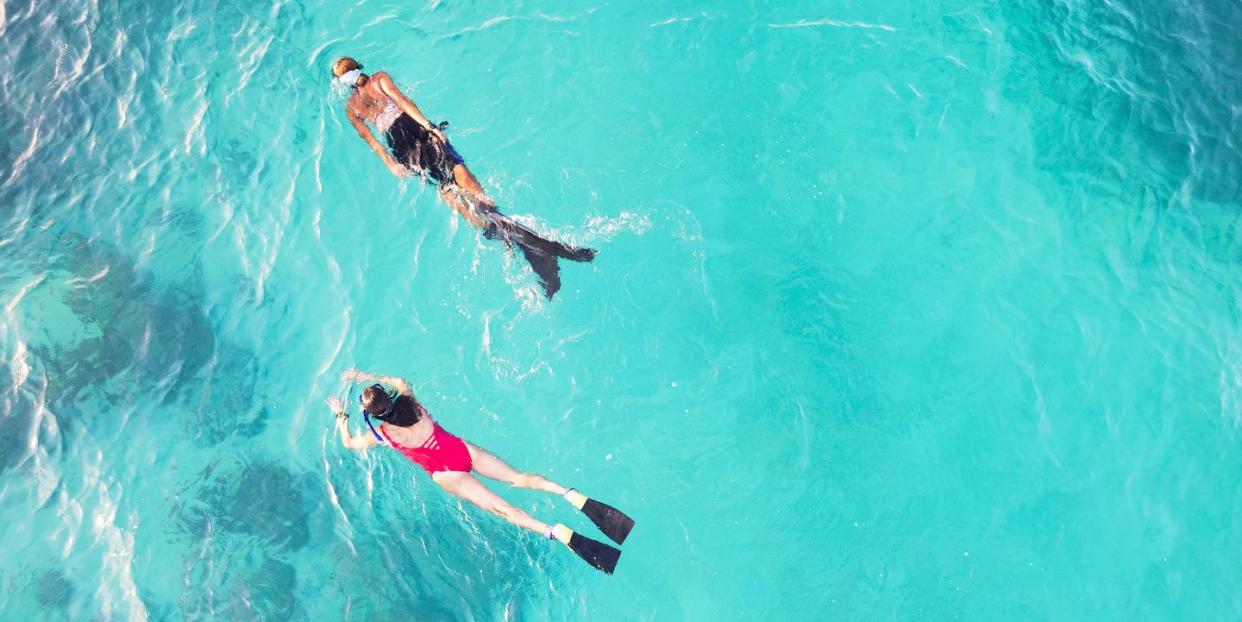
"Hearst Magazines and Yahoo may earn commission or revenue on some items through these links."
The Atlantic Ocean is a turquoise blanket unfurled to the horizon beyond the white sand beach of the Grace Bay Club, a luxury resort in Turks and Caicos.
My husband, Adrian, and I haven’t traveled as a couple since I was 16 weeks pregnant with our oldest daughter, who is now 4½. We left San Antonio, Texas, before the kids were awake, and I keep startling to the awareness of something missing, my hands opening and closing like fish mouths, so accustomed to small palms nestled inside. I miss our babies, and I’m glad we’re alone. I can’t be somebody’s mom on this trip, not while following the trail of my own fascination.
We’re here in Providenciales, Turks and Caicos, to meet Arenthia Baker, one of few Black women freedivers and mermaids (with a heavy emphasis on the latter; she’s a certified mermaid through the Professional Association of Diving Instructors), and Samantha (Sammy) Kildegaard, first Argentinian female freediver to set a national record in the constant weight monofin category. There are murmurs of a tropical storm moving toward us, shifting weather reports, but right now, with the sun bright and hot overhead, it’s hard to believe.
A few months ago, a Bookstagrammer I follow posted a video of herself gliding above the ocean floor in clear turquoise water, wearing a bathing suit, unusually long fins, and goggles–no snorkel, no oxygen tank. She was freediving. I lost track of time clicking through her ethereal videos, and the algorithm did the rest for me: Every time I logged in, I saw some version of a barefaced figure in a shimmering wet suit descending through a celestial column of light.
At first, the diver kicks, deceptively languid. Then, around 30 feet down, the kicks stop. In a disorienting reversal of gravity, the diver freefalls through the ocean, eyes closed and arms relaxed as they soar down, down, down to where sunlight disappears and the water deepens to a strange twilight blue, then deepest midnight, lit only by a headlamp, like an astronaut flying through a dreamscape galaxy.
Also known as apnea, breath holding, or skin diving, freediving is the act of holding one’s breath underwater without a breathing apparatus. Still, I remember thinking there had to be a hidden tank, clever editing—something to explain how ordinary human beings were capable of descending to such astonishing depths, sometimes up to 400 feet on a single breath. Who were these people, transcending the limits of the human body, defying their own mortality? What have they discovered in themselves that gives them access to such possibility? What could I learn from them?
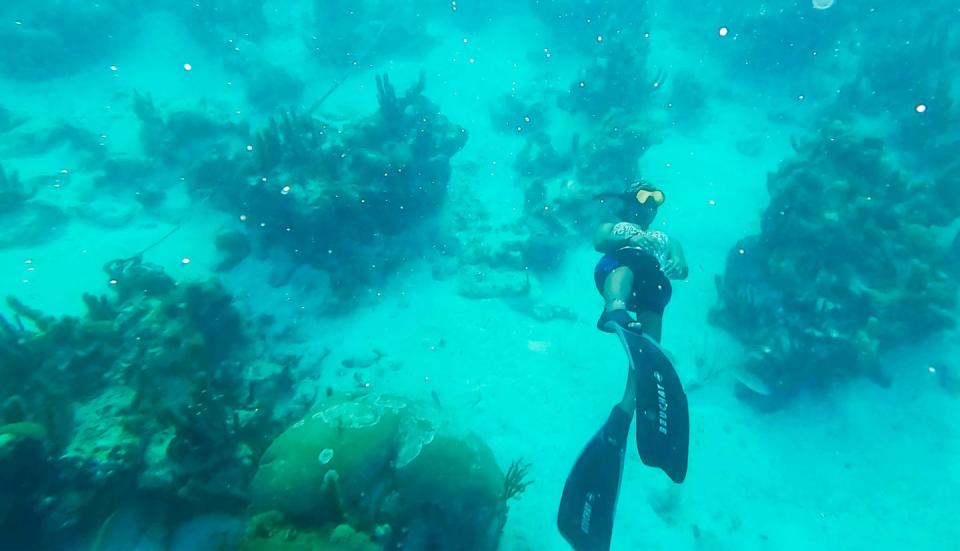
The first step in learning to freedive is, perhaps ironically, learning to breathe. Beside the hotel’s long, rectangular adults-only pool, Sammy, who runs her own freediving school, guides me through an hour of dry breathing exercises and stretches before loaning me a pair of carbon fins and a low-profile freediving mask. She has the relaxed energy of a yoga instructor with the focus and resolve of a competitive athlete, and I trusted her from the moment I met her. She lays a freediving rope on the bottom of the pool and weighs it down on each end. Before freediving for depth, I’ll be practicing dynamic apnea, or holding my breath for distance.
Though competitive freediving is relatively new—sanctioned in the 1970s by the World Confederation of Underwater Activities (CMAS)—freediving itself is an ancient practice, dating back some 8,000 years. “Sea sponge diving” was an Olympic sport for the ancient Greeks. And later, Japanese ama, or sea women, numbered in the tens of thousands, diving up to 150 feet and staying there for minutes at a time to collect pearls and seafood.
In the waters off Indonesia, Malaysia, and the Philippines, the Bajau people, or “sea nomads,” sometimes spend more than five hours a day diving, using only handmade goggles and spearguns to catch fish and octopus at depths of more than 230 feet. They’ve been living this way for more than 1,000 years. In 2015, geneticist Melissa Ilardo, who was studying the physiology and genetics of human hypoxia (oxygen deficiency) tolerance, traveled to visit and dive with the Bajau. With an ultrasound machine, she discovered that they have spleens up to 50 percent larger than the neighboring, land-dwelling Saluan people, suggesting they’ve actually evolved to be capable of holding their breath for long periods of time at great depth.
In the freediving world, the mammalian dive reflex—also known poetically as the “Master Switch of Life”—refers to the physical transformation that happens when the human body is immersed in cool water.
First, the heart slows, using less oxygen; at depths of 250 feet, freedivers have reported heart rates as low as 14 beats per minute. Next, blood is redirected from the extremities to the vital organs, keeping the brain and heart oxygenated longer. As the lungs constrict, blood vessels engorge to prevent them from collapsing. Finally, the spleen contracts, releasing up to 15 percent more oxygen-rich blood into the bloodstream, which is why the larger spleens of the Bajau are so interesting.
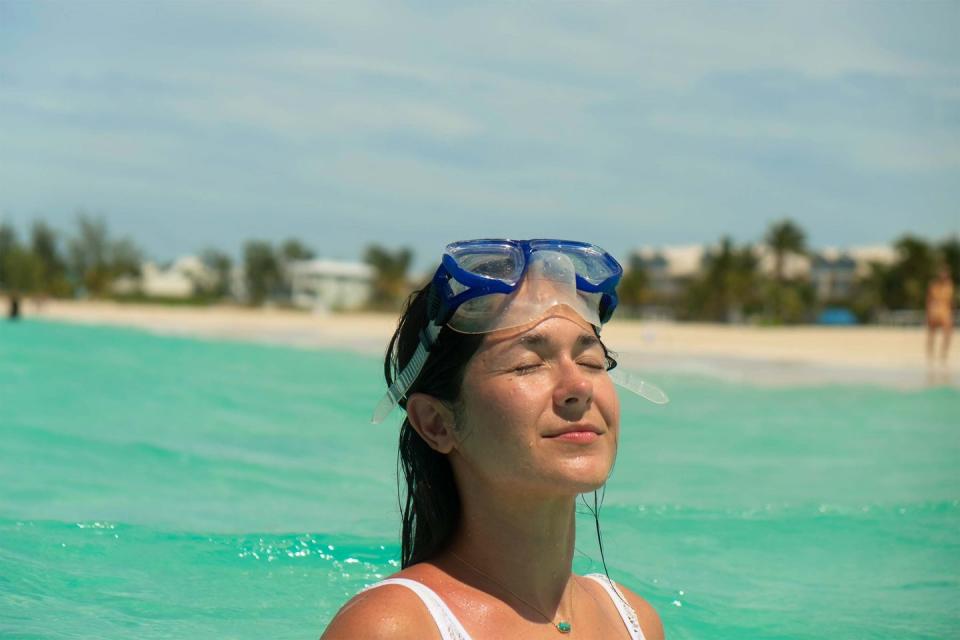
This idea that water—which constitutes more than half our bodies and 90 percent of our blood plasma—holds the key to some kind of metamorphosis is irresistible to me. And I wonder: If the body is capable of such transformation in the deep, what about the mind? And how might such an experience impact life on land?

Turks and Caicos Barrier Reef is one of the world’s largest barrier reefs and shields Grace Bay Beach from large waves, keeping the water unusually calm and still. Bight Reef, also known as Coral Gardens, is located on the western side of Grace Bay and consists of one main coral ridge that extends about 350 feet from the shore. This is among Arenthia Baker’s favorite spots to start the day, when the moon is still a placid, bright eye over the ocean. I can see why.
Against the rhythmic whoosh of my own breath in the snorkel, the reef crackles with the dawn brigade of fish feeding off the coral. Every so often, Arenthia points, and I see what she sees: the pale balloon of a puffer fish; a cluster of invasive lionfish, their striped dorsal fins fanned like peacock feathers; a shadowy shift in the sand that reveals itself to be a large manta ray. When Arenthia wants to explore something more closely, she folds her body in half and dives toward the bottom, 15 or 20 feet down. She lingers long after most people would have surfaced.
“I’m a child of the ocean,” Arenthia told me. “My mom was from Turks and Caicos, and my father’s from Haiti, so my lineage is just all island heritage.”
Only 11 percent of scuba divers are Black, according to a survey by the Diving Equipment and Marketing Agency; racial demographics don’t seem to exist for freedivers. Arenthia, though, has been a freediver her whole life, diving on a breath hold before she knew freediving was a sport, an entire community, and subculture. She’s never competed in it, nor is she certified to teach by the Professional Association of Diving Instructors (PADI), yet freediving has defined the course of her life. She taught digital design to high schoolers in West Palm, but when COVID and the direction of American politics shifted the landscape for teachers in Florida, she sold her belongings and lined up housing in Providenciales. In summer 2021, she made the move.
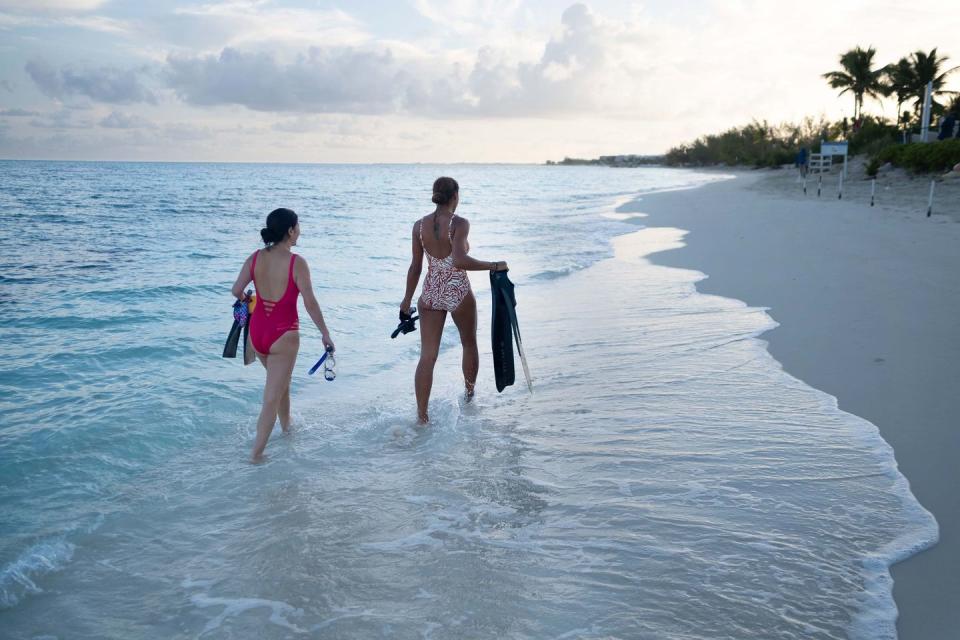
Today, Arenthia uses her passions to fund her life. In season, she works on a liveaboard boat, where recreational scuba divers live for the duration of their expedition—most often a week at a time—and accompanies guests on two or three dives a day. She works on charter boats and as a guide on a semi-submarine. She volunteers with the nonprofit Turks and Caicos Reef Fund to clean coral trees underwater and outplant coral and takes video and photos for the organization’s marketing. And, on her own time, she freedives.
One morning in 2021, as Arenthia arrived at Coral Gardens, another woman was packing up after a swim. The woman noticed Arenthia’s freediving fins—it’s rare to see women with them on the island—and introduced herself. It was Sammy Kildegaard. By the next month, Arenthia was on a boat with her to West Caicos for freediving line training, or descending in open water while clipped to a rope to hone techniques such as relaxation, breath holding, duck diving, rope orientation, and recovery. With Sammy’s instruction, Arenthia hit her personal record of 60 feet on one breath hold.
Sammy was born in Argentina, where at 14 she was diagnosed with scoliosis, a sideways curvature of the spine that can cause pain and breathing issues. Her doctor gave her several options for therapeutic exercise: tennis, rowing, or swimming. She chose swimming. Over the next year, she swam for two hours a day.
“I was able to heal 99.9 percent,” Sammy says. “When I say the water is a very healing place, I’ve seen it. I’ve experienced it. I am a witness.” After a career as a professional translator, Sammy traveled the world as a scuba instructor, set records as a competitive freediver, and ended up here, running her own school.
The notion of water as healer opens a window for a question I need to ask, which is: What about when it’s not? The death rate for competitive freedivers is surprisingly low: only one in the more than 50,000 competitive dives on record. But recreationally, without the proper training, gear, and accompanying safety divers, the death rate soars to 1 in 500 dives. What makes it worth the risk?
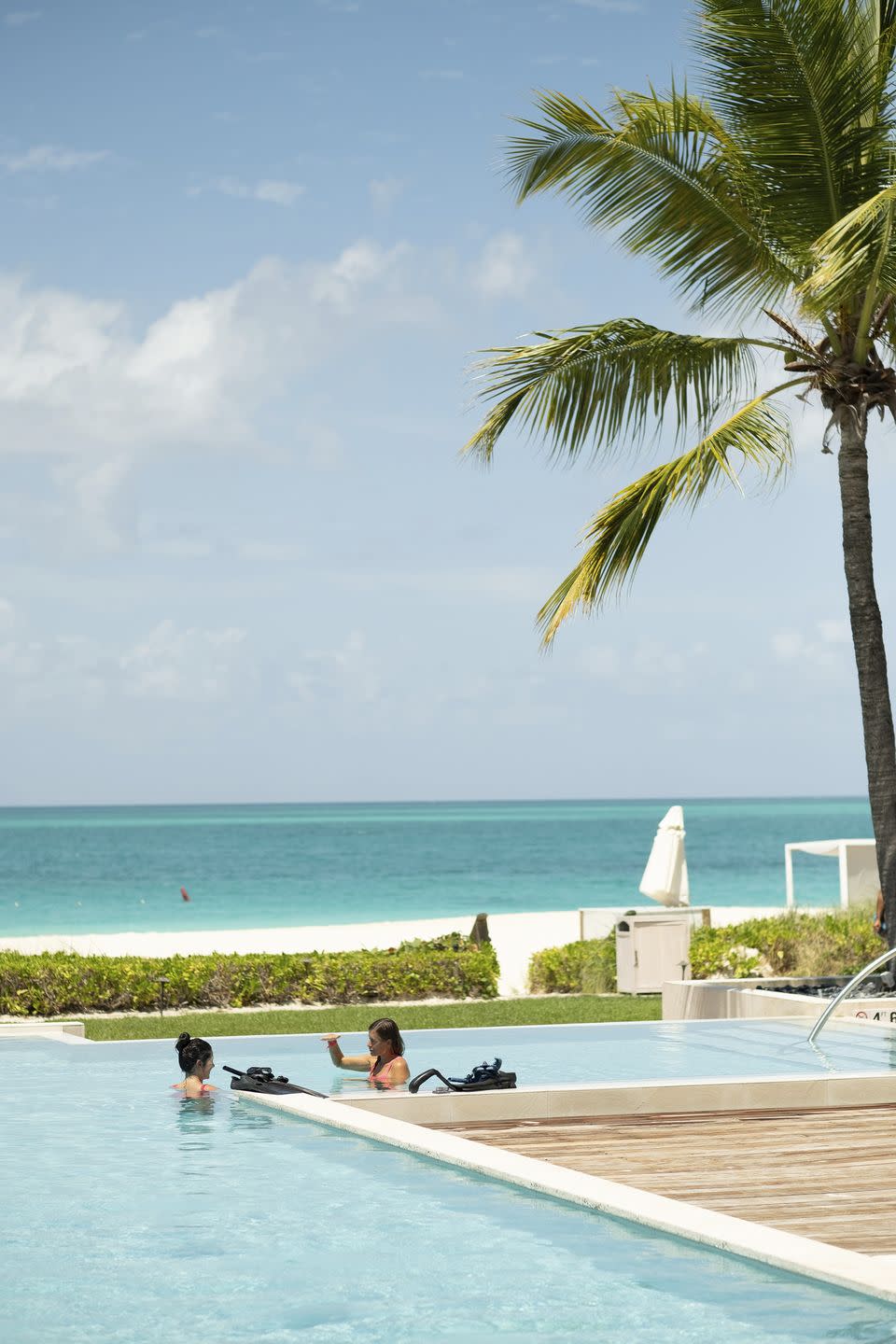
Across the breakfast table, Sammy and Arenthia exchange knowing glances. Arenthia pulls up GoPro videos she’s taken on dives: a playful sea turtle circling her in Coral Gardens; a spotted eagle ray gliding like a giant butterfly in the deep; a mother whale teaching her calf how to surface and breathe. Sammy tells us about a time she encountered a male whale hovering at 50 meters.
“His eyes were closed, and he was singing,” she says.
“When a whale sings, you can feel the vibration in your body,” Arenthia says.
Sammy sighs. “You can feel it in your heart.”
“With freediving, I’m in control of my body and mind,” Arenthia says. “I can trust myself. When I’m out in the world, I’m at my most vulnerable because I’m not in control. I need to freedive so I can handle life outside the water.”
Arenthia’s point turns my own conception of freediving—that you are not in control, that you are at the mercy of an environment in which you don’t belong—on its head. There must be moments of fear, I insist. Of panic. What’s it like to feel that you’re running out of breath and then look up to see 60 feet of water?
“I never look up,” Arenthia says simply. Sammy nods. “Freediving is about staying in the moment. ”
“In those moments, I practice telling myself, ‘You’ve got 30 percent more,’ ” Arenthia says. “When you feel you’re about to give up, you’ve got a little bit more. Then you do it, and you feel like a superhero.”
Sammy smiles at me. “You’ll see.”

The Grace Bay Club was built by Grace Bay Resorts, a developer of luxury resorts and residences on the island. Two wings of the hotel are being renovated, and the adults-only pool is closed, but a manager has been allowing us to use the area for lessons. The pool extends toward the ocean like an outstretched arm. The only hint that a storm may be coming is the wind, whipping this morning’s still water into small white tips.
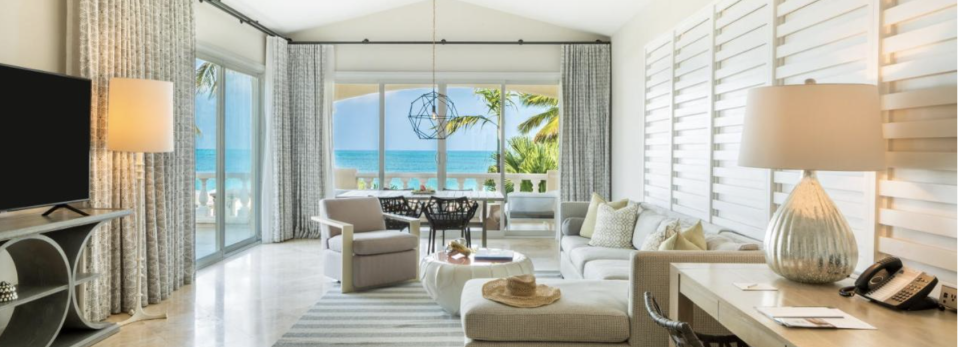
Grace Bay Club
$730.00
booking.com
Sammy directs me to lie on my back on a lounge chair. Women typically have a lung capacity of four liters, which Sammy says can be trained, with specific breathing and intercostal stretching, to hold as much as possible. She tells me to put one hand on my belly and one on my chest. We practice breathing into the belly and directing that air up toward the chest—inhale for three seconds, pause, release tension from the shoulders, and exhale for six seconds. I find myself light-headed, shoulders near my ears.
“Any stress, any fears you have in freediving,” Sammy says, “you won’t go any further before dealing with it—like in life. Freediving is a special environment, a powerful tool to help overall well-being”
Tension, fear. Life, for the past two and a half years. Sammy guides me on how not to take in too much air, how to breathe as if through a straw, how to take a recovery breath: a sharp inhale at the surface, followed by a quick exhale; repeat. This should be followed by the A-OK hand signal and verbally confirmed with “I’m okay.”
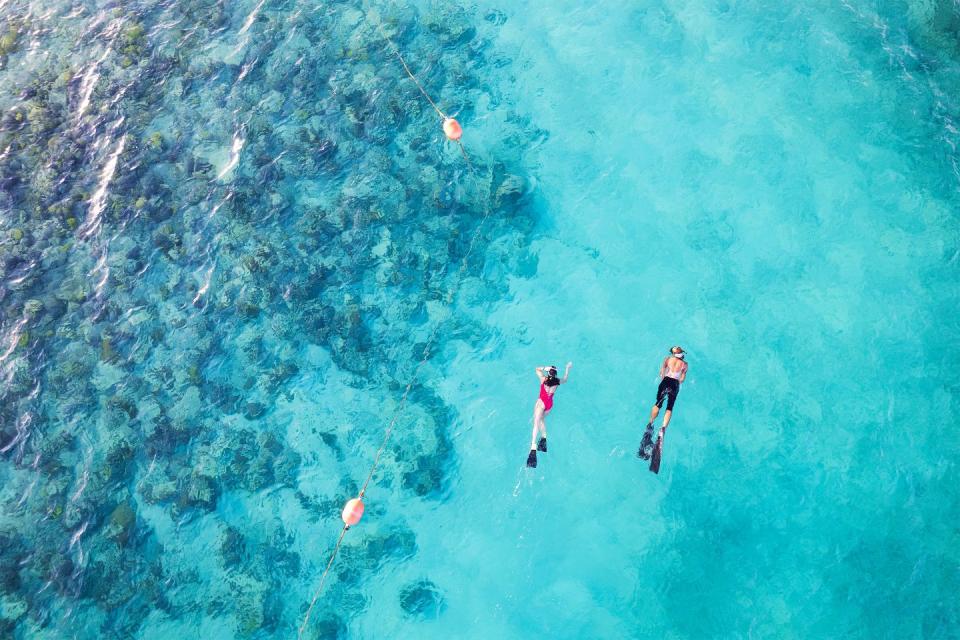
After 40 minutes, we’re ready to try a breath hold. Sammy pulls out her stopwatch and tells me to breathe normally for one minute. Then she uses a technique called concentration/de-concentration, pioneered by Natalia Molchanova, “the mother of freediving.” (Molchanova held 41 world records when, tragically, she never resurfaced from a dive off the island of Formentera in 2015.)
“First, concentrate on what you hear, and shut everything else out,” Sammy says.
I listen to the roar of the ocean. Then Sammy instructs me to focus on what I feel: the sun burning my legs, the soft breeze. She tells me when to move the air into my chest, but my belly feels too full. “Release your tension,” Sammy says, and she talks me through relaxing one body part at a time. I’m focusing so intently that I’m not thinking about breathing. The air in my body feels like enough to sustain me, until it doesn’t.
I know from my research that the brain’s first urge to breathe is a reaction to the buildup of carbon dioxide—you actually have minutes of oxygen left, if you can stay calm through that forceful urge and ride out the convulsions that follow. I open my eyes before they start.
“Recovery breath,” Sammy says promptly.
I take that sharp inhale, then exhale. I forget to do the hand signal and “I’m okay” until Sammy reminds me.
“How do you feel?” she asks. I’m not light-headed. My heart rate feels calm. That couldn’t have been more than 40 seconds, I think. “Good,” I say.
She shows me the stopwatch: 1 minute and 22 seconds. All I can do is laugh, exhilarated.
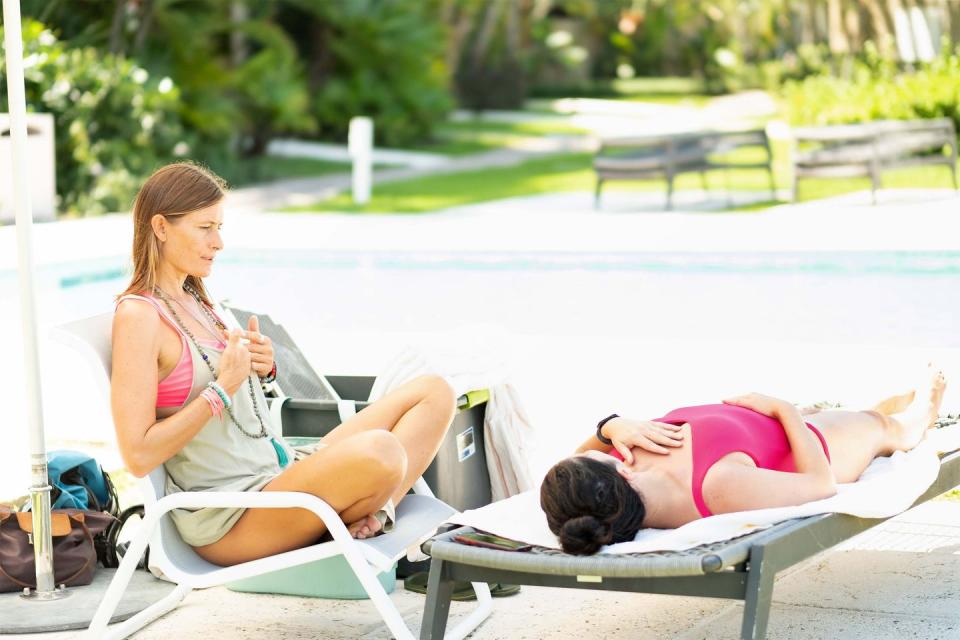
In the pool, Sammy explains how to integrate our dry breathing exercises with equalizing and duck diving. Next, she explains how to kick. I was a swimmer in high school. I know the adrenaline of racing through a length of pool, legs churning like a motor. This is the opposite. The goal is maximum efficiency with the least energy. Sammy instructs me on kicking from my hips, then gliding as long as possible before kicking again. My eyes should be on the rope the whole time, arms flush against the sides of my head, fingers overlapping into a point sharp enough to cut through any drag.
I focus on bringing together everything Sammy taught me, a dizzying number of tiny adjustments to my body’s instinctive, or habitual, ways of doing things. I equalize, duck dive, push off the wall. Kick and glide, kick and glide, eyes following the white rope on the pool bottom. I can feel Sammy swimming beside me, observing, but mostly I feel alone and relaxed, centered and at peace.
When the rope runs out, I’m surprised, and nearly hit my head on the pool wall. Sammy cheers when I come up for air. I’m estimating that was 20 meters on one breath, which, translated to depth, might mean 30 feet down.
“How do you feel?” Sammy asks. “Good,” I say, then consider my body more carefully. “I feel…strong.”
In 2017, I got pregnant after a struggle with infertility. At that point, I practiced Pilates every day and ran a half-marathon once a year. Then, at 11 weeks, a debilitating pregnancy condition called symphysis pubis dysfunction derailed me. My husband had to help me in and out of bed. He held my hips together as he shuffled me to the bathroom. I needed a crutch to walk. The condition returned even earlier during my second pregnancy. Our son arrived in 2020, during lockdowns, quarantines, isolation—when society as a whole felt most vulnerable and so did my body, transformed by pregnancies and births and my own awareness of its inherent fragility. It has been a long, long time since I’ve felt strong. But I do now.
“Are you ready to go again?” Sammy asks, and I say yes. I want to do this all day. We practice with bi-fins and using them as a monofin and without fins at all. We practice with a three-pound Lobster weight collar, which follows the movement of the dorsal vertebrae and counters buoyancy. By the end of our session, I can go a length and a half—about 30 meters, or 90 feet, on one breath. Tomorrow, if the weather holds, we’ll go to the ocean—perhaps to Coral Gardens, where we snorkeled with Arenthia earlier, or to Smith’s Reef, another favorite spot of theirs. I am ready.
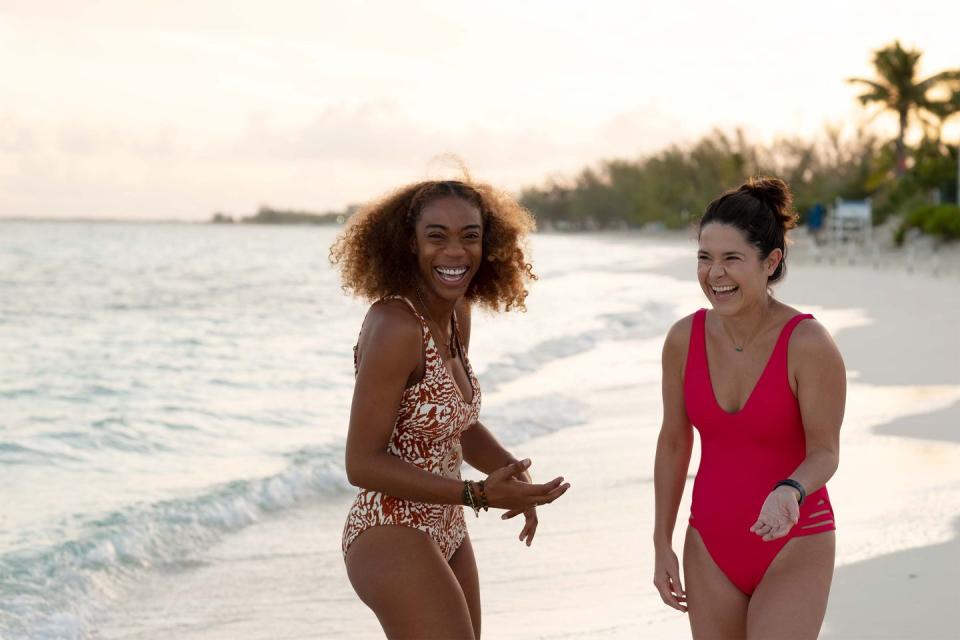
We never make it to the ocean. Tropical Storm Fiona strengthens into a hurricane, devastating the Dominican Republic and Puerto Rico before blowing toward Turks and Caicos. The airport shuts down. A curfew is imposed. With calm and practiced efficiency, the staff at Grace Bay Club disassemble and reinforce furniture, and push sandbags up against first-floor doors. Hotel guests are treated to dinner and a round of drinks, an air of nervous merriment as the sky broods darker.
When we return to our room, a care package filled with sandwiches and wraps, fruit and cereal, cold pasta salad and pastries, awaits us. The mini fridge is stocked with 15 bottles of water. It hits me that this is it; the storm is coming and we can’t escape it.
Earlier, I chatted with a housekeeper named Maureen. She’s from Jamaica but has lived in Providenciales for 15 years. She was here for Hurricane Irma, when her home in the valley flooded and they were left without power for three months. Despite everything, she told me, she loves watching the wind and rain of hurricanes.
“Man has tried to control so much,” she said, “but this is one thing you can’t do anything about. This is God in all his glory, and that’s a beautiful thing.”
That night, Adrian and I lie in bed as rain pelts the doors and wind thrashes the walls. Our room faces the ocean, and I imagine black water rising, encroaching in the darkness, slowly, then all at once. I imagine myself in the deep, hundreds of feet below the surface, out of breath.
Then I hear Arenthia’s voice: “Don’t look up. You’ve always got a little more.” I close my eyes, place one hand on my belly and another on my chest. As the hurricane makes landfall, I breathe.

This article originally appeared in the July/August 2023 issue of Women's Health.
You Might Also Like

